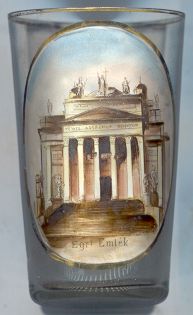

|
| MAGYARORSZÁG | HUNGARY |
| megye: Heves |
Eger is situated at an elevation of 165 m east of the Mátra mountains in northern Hungary. Eger is the capital of the county (megye) Heves and has a population of about 57,000 (2001).
Eger is one of the oldest towns in Hungary. It became the seat of a bishopric at the beginning ot the 11th century.
In 1241 it was destroyed completely by the Mongoles and most of its inhabitants were killed.
The 14th-16th centuries were an age of prosperity for Eger. Winegrowing, for which the town is famous,
began to be important at that time.
During the Turkish occupation of Hungary, Eger became an important border fortress.
In 1552 the defenders of the castle (less than 2100 people, including women and children) cuold successfully
defeat a Turkish army of about 80,000 soldiers so that it was hoped that the Turkish expansion was stopped.
However, in 1596 the Osman troops
finally took Eger, which then remained under Turkish rule for more than 90 years. The Turks built many important
buildings in Eger, which had become the capital of a Turkish administrative district.
The minaret of Eger is considered the northernmost historic building of
the Ottoman Empire in Europe. In 1687 Eger was recaptured by the Austrian and Hungarian armies.
The town then again came in possession of the bishops who forced many Protestant inhabitants to leave the town.
The 18th century was another flourishing period for Eger. The town became the seat of an archbishop in 1804.
The inhabitants of Eger took active part in the revolution of 1848 and although the revolution eventually was suppressed,
Eger became free from the archbishop's rule in 1854. Sadly, Eger was left off the main railway line between
Budapest and Miskolc, leaving the role of railway junction to the
 nearby small town Füzesabony.
After World War I the economic life started only slowly, but the constructing of new buildings began in 1925.
Géza Gárdonyi's novel "Eclipse of the Crescent Moon" (published 1899, original title 'Egri csillagok', 'Stars of Eger'),
which described the defeat of the Turks in 1552, made Eger popular as a tourist attraction.
Eger is also known world-wide for its famous red wine, Egri bikavér (Eger bull's blood).
nearby small town Füzesabony.
After World War I the economic life started only slowly, but the constructing of new buildings began in 1925.
Géza Gárdonyi's novel "Eclipse of the Crescent Moon" (published 1899, original title 'Egri csillagok', 'Stars of Eger'),
which described the defeat of the Turks in 1552, made Eger popular as a tourist attraction.
Eger is also known world-wide for its famous red wine, Egri bikavér (Eger bull's blood).
The  Metropolitan Cathedral Basilica of St. John the Apostle and Evangelist, St. Michael and the Immaculate Conception
(Szent János apostol és evangélista, Szent Mihály főangyal, Szeplőtelen Fogantatás főszékesegyház bazilika)
was built in 1831–1836 in Neo-Classical style by the architect József Hild. It is the second-largest church
in Hungary after the cathedral of Esztergom. The church measures 93 by 53 m,
the two towers each have a height of 54 m. The cathedral has Hungary's largest organ which is still in use.
The organ was built in 1864 and has 149 ranks and 99 stops.
The church gained the status of a Basilica minor in 1970.
Metropolitan Cathedral Basilica of St. John the Apostle and Evangelist, St. Michael and the Immaculate Conception
(Szent János apostol és evangélista, Szent Mihály főangyal, Szeplőtelen Fogantatás főszékesegyház bazilika)
was built in 1831–1836 in Neo-Classical style by the architect József Hild. It is the second-largest church
in Hungary after the cathedral of Esztergom. The church measures 93 by 53 m,
the two towers each have a height of 54 m. The cathedral has Hungary's largest organ which is still in use.
The organ was built in 1864 and has 149 ranks and 99 stops.
The church gained the status of a Basilica minor in 1970.
(see also list of other basilicae minores depicted on glasses of this collection)
Eger is also the German name for Cheb in the Czech Republic.
![[scale]](lineal.jpg)